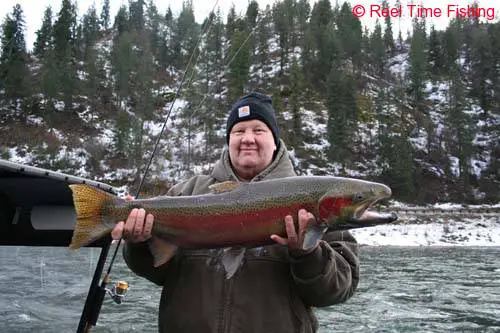Search
Latest Articles
Clearwater Winter Steelhead
by Mike Carey, January 31, 2017
The Clearwater River runs 75 miles long in north central Idaho. It flows westward from the Bitterroot Mountains and joins the Snake River. The Snake River in turn joins the Columbia River. What all this means to Pacific Northwest anglers is that steelhead that return to the Dworshak Hatchery on the Clearwater travel one heck of a long journey to return home. Clearwater steelhead are tough, sturdy fish! In addition, these “B” run steelhead get big – really big. You may ask, “how big do they get?” I put that question to guide Kyle Jones of Jones Sport Fishing. He told me that the late winter run fish run 12-15 pounds, and it’s not uncommon to catch 17-19 pound bucks. Are you kidding me? That’s a big steelhead by anyone’s measure and well worth the drive to Idaho to fish this trophy steelhead fishery.

Let’s learn more about this amazing steelhead fishery within a day’s drive from the greater Puget Sound region.
First off, like most fisheries in the Pacific Northwest, while there are native fish in the Clearwater, this is primarily a hatchery fishery. The Dworshak Hatchery on the Clearwater River is a mitigation hatchery, put in place in 1969. It is run by the Nez Pez Tribe and the U.S. Fish and Wildlife Service. It’s one of the largest anadromous (migratory) fish hatcheries in the world. The salmon and steelhead that are released travel an amazing 1,000 miles round trip to the ocean, through eight dams. Like I said earlier, this epic journey makes for some incredibly tough fish that will challenge an angler with their size and fighting abilities.

I asked Kyle if the dam upriver from where he and fellow guide Toby Wyatt fish had a big impact on the fishing, knowing that dams can sometimes kill a bite faster than a cold front. Kyle told me “actually, we like it when the dam spills some water, it improves the bite”. Kyle told me that the river generally has a fairly consistent flow. In addition, the water is warmer in late winter meaning the fish tend to be more active and aggressive than they were earlier in the winter. And they put up a better fight according to Kyle.
So what’s the preferred method of fishing from a boat? “Definitely side drifting”, said Kyle. “That method is hands down what most boats will use. The Bite is hardly subtle, and there’s nothing like being one on one with a big, angry steelhead”. Side drifting is a well know technique wherein the boat operator keeps the boat steadily drifting down river while the anglers feel their baits bouncing along the bottom at a 45 degree angle upstream from the boat. It can be devastatingly effective on steelhead and is an easy technique to learn. Kyle likes to use either eggs and yarn or pegged beads on the terminal end of the line.
Kyle noted that unlike many rivers in the west side of Washington, on the Clearwater there is plenty of room to spread out and fish. Fishing by the hatchery of course will have more boats, but even so it’s nothing like the craziness anglers put up with on the west side Washington steelhead rivers.
If you’re a bank angler the Clearwater has a lot of beautiful drifts and almost unlimited access along its entire 70 mile length. Floats and jigs are a great way to work the river. That said, being in a boat naturally gives you a lot more river to explore and work over.
The Clearwater does have a native fish return so anything with an adipose fin must be gently released. But make no mistake, those big 17-19 pound fish I mentioned are very often hatchery fish. If you decide to keep one, how do they taste? “They’re good”, Kyle said, “they aren’t chromers after a 500 mile journey, but they are edible for sure. A lot of guys do like to smoke them and they smoke up very well”.
I didn’t mention, the Clearwater River and surrounding hills are beautiful. The area is peaceful and quiet. The majority of the river is undeveloped. It’s a true steelheader’s delight and one that once you’ve fished you’ll want to return and fish again.
If you’re interested in learning more and actually fishing this river, Kyle Jones of Jones Sportfishing and Toby Wyatt of Reel Time has made arrangements with Northwest Fishing Reports for a great deal you won’t want to miss.
A full day of fishing including lunch, and a nights lodging at the Lenore Lodge (208-790-2128), plus free swag from Northwest Fishing Reports and the chance to be part of a future episode on the NWFR You Tube Channel and our FOX TV show! The regular rate would be $310, but for this member's adventure it's just $260!
We hope you’ll take advantage of the special rate and opportunity to fish this incredible river. It’s not uncommon to have twenty fish days and great chances for a trophy sized steelhead!
Call Toby Wyatt at 1-208-790-2128 today to fish with us March 3-4th. See you there!








